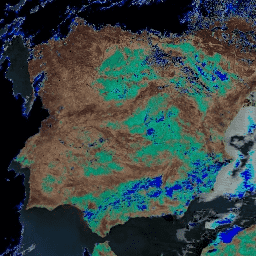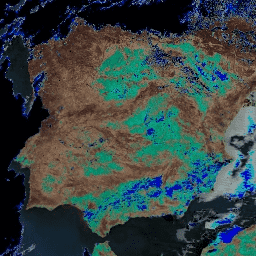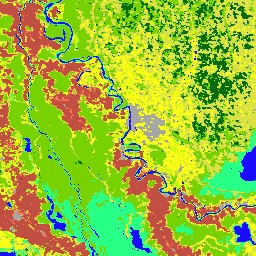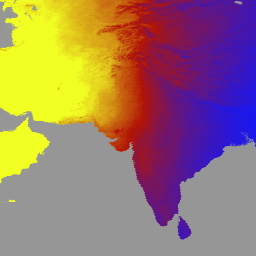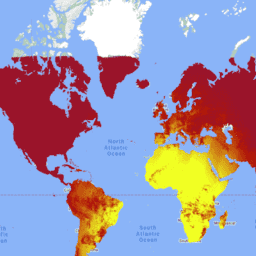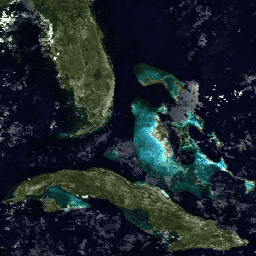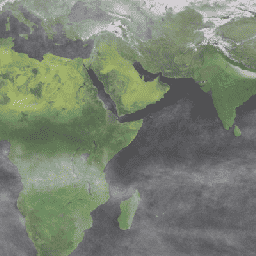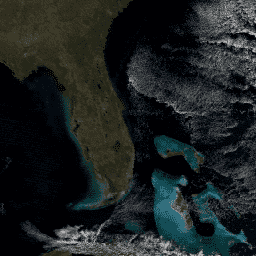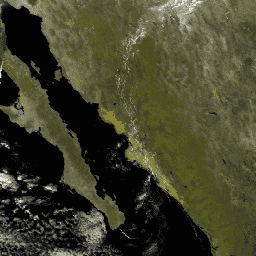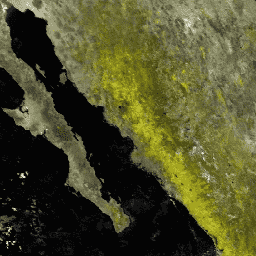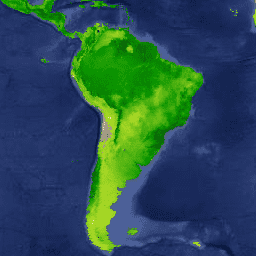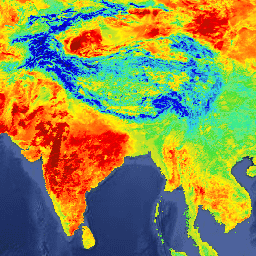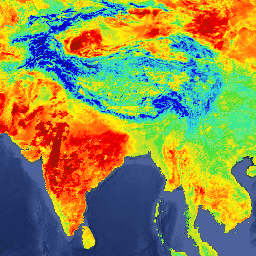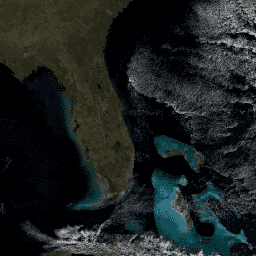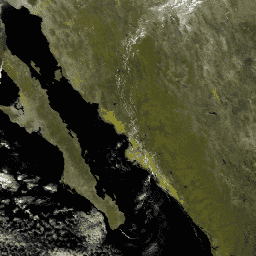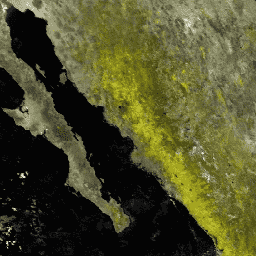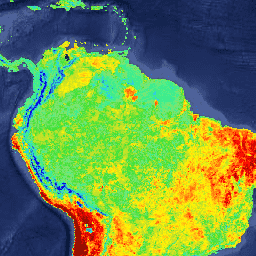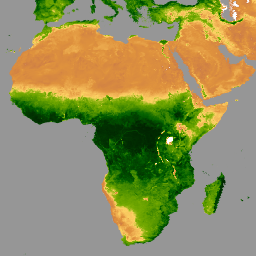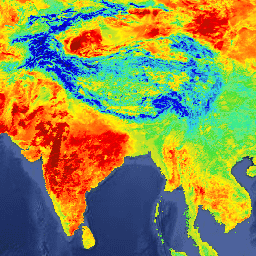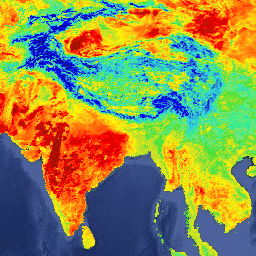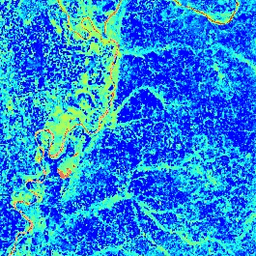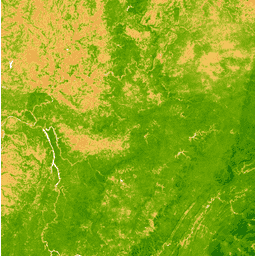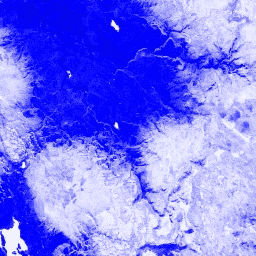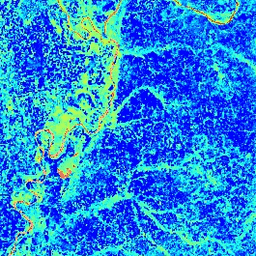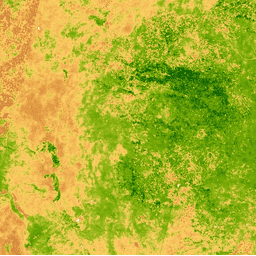MOD44B.006 Terra Vegetation Continuous Fields Yearly Global 250m
Terra MODIS 植被连续场 (VCF) 产品以亚像素级表示全球地表植被覆盖率估算值。旨在以基本植被特征的比例连续表示地球陆地表面,提供三个地表覆盖成分的梯度:树木覆盖率、非树木覆盖率和裸地覆盖率。VCF 产品可以持续定量地描绘地表覆盖情况,并提供更详细的空间信息,因此广泛应用于环境建模和监测应用。
photo_library
MODIS/006/MOD44B
MOD44W.006 Terra Land Water Mask Derived From MODIS and SRTM Yearly
Global 250m
MOD44W V6 陆地/水体掩膜 250 米产品是使用基于 MODIS 数据训练并使用 MOD44W V5 产品验证的决策树分类器生成的。应用一系列掩模来解决已知问题,这些问题是由地形阴影、烧伤疤痕、多云或海洋冰盖造成的。
photo_library
MODIS/006/MOD44W
MODOCGA.006 Terra Ocean Reflectance Daily Global 1km
MODOCGA V6 海洋反射率产品包含 Terra MODIS 波段 8-16 的 1 公里反射率数据。该产品被称为海洋反射率,因为波段 8-16 主要用于生成海洋产品,但由于生成的图块是陆地图块,因此该产品不是海洋产品。
photo_library
MODIS/006/MODOCGA
MYDOCGA.006 Aqua 海洋反射率每日全球 1 公里
MYDOCGA V6 海洋反射率产品包含来自 Aqua MODIS 波段 8-16 的 1 公里反射率数据。该产品被称为海洋反射率,因为波段 8-16 主要用于生成海洋产品,但由于生成的图块是陆地图块,因此该产品不是海洋产品。
photo_library
MODIS/006/MYDOCGA
MCD12C1.061 MODIS 土地覆盖类型年度全球 0.05 度 CMG
Terra 和 Aqua 组合的中分辨率成像分光辐射计 (MODIS) 土地覆盖气候建模网格 (CMG) (MCD12C1) 版本 6.1 数据产品提供了平铺 MCD12Q1 版本 6.1 数据产品的空间聚合和重新投影版本。2001 年至 2022 年,我们以 0.05 度(5,600 米)的空间分辨率,按年度间隔提供国际地圈生物圈计划 (IGBP)、马里兰大学 (UMD) 和叶面积指数 (LAI) 分类方案的地图。此外,还提供了每个 0.05 度像素中每个土地覆盖类别的亚像素比例,以及三种土地分类方案中每种方案的汇总质量评估信息。
photo_library
MODIS/061/MCD12C1
MCD12Q1.061 MODIS 土地覆盖类型年度全球 500 米
Terra 和 Aqua 组合的中分辨率成像分光辐射计 (MODIS) 土地覆盖类型 (MCD12Q1) 6.1 版数据产品以年度为间隔提供全球土地覆盖类型。MCD12Q1 第 6.1 版数据产品是使用 MODIS Terra 和 Aqua 反射率数据的监督分类推导出来的。土地覆盖类型源自国际地圈生物圈计划 (IGBP)、马里兰大学 (UMD)、叶面积指数 (LAI)、生物群落-生物地球化学循环 (BGC) 和植物功能类型 (PFT) 分类方案。监督分类随后会进行额外的后处理,其中会结合先验知识和辅助信息,进一步优化特定类别。此外,粮农组织 (FAO) 土地覆盖分类系统 (LCCS) 还提供了其他土地覆盖属性评估图层,用于评估土地覆盖、土地利用和地表水文情况。
photo_library
MODIS/061/MCD12Q1
MCD12Q2.006 土地覆盖动态年度全球 500 米
Terra 和 Aqua 组合中分辨率成像分光辐射计 (MODIS) 土地覆盖动态 (MCD12Q2) 6.1 版数据产品以年度间隔提供全球地表物候指标。MCD12Q2 版本 6.1 数据产品源自时序数据,这些时序数据是根据 MODIS Nadir 双向反射分布函数 (BRDF) 调整后的反射率 (NBAR) 计算出的双波段增强型植被指数(EVI2)。以 500 米的空间分辨率确定植被物候指标,每年最多可检测到两个生长周期。对于具有两个以上有效植被周期的像素,数据表示 NBAR-EVI2 幅度最大的两个周期。
photo_library
MODIS/061/MCD12Q2
MCD15A3H.061 MODIS 叶面积指数/光合有效辐射吸收比 4 天全球 500 米
MCD15A3H 版本 6.1 中分辨率成像分光辐射计 (MODIS) 4 级产品,结合了光合有效辐射 (FPAR) 和叶面积指数 (LAI) 的分数,是一个 4 天合成数据集,像素大小为 500 米。该算法会从 NASA Terra 和 Aqua 卫星上 MODIS 传感器在 4 天内采集的所有数据中选择最佳像素。
photo_library
MODIS/061/MCD15A3H
MCD18A1.061 地表辐射每日/3 小时
MCD18A1 第 6.1 版是中分辨率成像分光辐射计 (MODIS) Terra 和 Aqua 组合的下行短波辐射 (DSR) 网格化 3 级产品,每天以 1 公里像素分辨率生成,并每 3 小时估算一次 DSR。DSR 是指短波谱(300-4,000 纳米)中陆地表面上的入射太阳辐射,是陆地表面模型中的一个重要变量,可用于解决各种科学和应用问题。MCD18 产品基于原型算法,该算法使用 MODIS 数据的多时相特征来推导地表反射率,然后使用查找表 (LUT) 方法计算入射 DSR。LUT 考虑了各种照明/观测几何条件下不同类型的气溶胶和云载荷。全球 DSR 产品由 MODIS 和地球静止卫星数据生成。如需了解有关用于创建数据的具体方法,请参阅算法理论基础文档
photo_library
MODIS/061/MCD18A1
MCD18C2.061 光合有效辐射每日 3 小时
MCD18C2 第 6.1 版是中分辨率成像分光辐射计 (MODIS) Terra 和 Aqua 组合光合有效辐射 (PAR) 网格化 3 级产品,每天以 0.05 度(赤道处为 5,600 米)分辨率生成,并每 3 小时估算一次 PAR。PAR 是可见光谱(400-700 纳米)中的入射太阳辐射,是陆地表面模型中的一个重要变量,可用于解决各种科学和应用问题。MCD18 产品基于原型算法,该算法使用 MODIS 数据的多时相特征来推导地表反射率,然后使用查找表 (LUT) 方法计算入射 PAR。LUT 考虑了各种照明/观测几何条件下不同类型的气溶胶和云载荷。全球 PAR 产品由 MODIS 和地球静止卫星数据生成。如需了解有关用于创建数据的具体方法,请参阅算法理论基础文档
photo_library
MODIS/061/MCD18C2
MCD43A1.061 MODIS BRDF-Albedo 模型参数,每日,500 米
MCD43A1 V6.1 双向反射分布函数和反照率 (BRDF/Albedo) 模型参数数据集是 500 米分辨率的 16 天日产品。儒略日表示 16 天检索期内的第 9 天,因此观测结果会加权,以估算当天的 BRDF/反照率。MCD43A1 算法与其他所有组合产品一样,会从一个包含 Terra 和 Aqua 传感器在检索期内所有采集数据的池中选择最具代表性的像素。
photo_library
MODIS/061/MCD43A1
MCD43A2.061 MODIS BRDF-Albedo Quality Daily 500m
MCD43A2 V6.1 双向反射分布函数和反照率 (BRDF/Albedo) 质量数据集是 500 米分辨率的 16 天日产品。它包含相应 16 天 MCD43A3 反照率和 MCD43A4 Nadir-BRDF (NBAR) 产品的所有质量信息。
photo_library
MODIS/061/MCD43A2
MCD43A3.061 MODIS 反照率每日 500 米
MCD43A3 V6.1 反照率模型数据集是每日 16 天产品。它为每个 MODIS 地表反射率波段(波段 1 至波段 7)以及 3 个宽光谱波段(可见光、近红外和短波)提供了方向半球反射率(黑空反照率)和双半球反射率(白空反照率)。每张 500 米/像素的每日图片都是使用以给定日期为中心的 16 天的数据生成的。此外,还为 10 个反照率波段中的每个波段提供了一个质量波段。
photo_library
MODIS/061/MCD43A3
MCD43A4.061 MODIS Nadir BRDF-Adjusted Reflectance Daily 500m
MCD43A4 V6.1 Nadir Bidirectional Reflectance Distribution Function Adjusted Reflectance (NBAR) 产品提供 MODIS“陆地”波段 1-7 的 500 米反射率数据。这些值使用双向反射分布函数进行调整,以模拟从天底视图收集的值。这些数据每天都会生成,检索期为 16 天,图像日期为第 9 天。
此产品结合了 Terra 和 Aqua 航天器的数据,并从 16 天的时间段内选择最具代表性的像素。
photo_library
MODIS/061/MCD43A4
MCD43C3.061 BRDF/反照率每日 L3 0.05 度 CMG
MCD43C3 版本 6.1 双向反射分布函数和反照率 (BRDF/Albedo) 反照率数据集每天使用 16 天的 Terra 和 Aqua MODIS 数据在 0.05 度(赤道处为 5,600 米)气候建模网格 (CMG) 中生成。数据按时间加权到检索期的第 9 天,这反映在文件名中的儒略日中。此 CMG 产品覆盖全球,可用于气候模拟模型。
photo_library
MODIS/061/MCD43C3
MCD64A1.061 MODIS 烧毁区域月度全球 500 米
Terra 和 Aqua 组合 MCD64A1 版本 6.1 烧毁面积数据产品是一个全球网格化月度产品,分辨率为 500 米,包含每个像素的烧毁面积和质量信息。MCD64A1 烧毁区域测绘方法采用 500 米 MODIS 地表反射率图像,并结合 1 公里 MODIS 主动火灾观测数据。该算法使用燃烧敏感植被指数 (VI) 创建动态阈值,并将其应用于合成数据。该植被指数 (VI) 是根据 MODIS 短波红外大气校正地表反射率波段 5 和 7 以及时间纹理测量值计算得出的。该算法可识别每个 MODIS 图块内 500 米网格单元的烧毁日期。日期以单个数据层编码,表示发生火灾的日历年中的序数日,未燃烧的土地像素被分配了值,缺失数据和水网格单元保留了额外的特殊值。
photo_library
MODIS/061/MCD64A1
MOD08_M3.061 Terra Atmosphere Monthly Global Product
MOD08_M3 V6.1 是一种大气全球产品,其中包含大气参数的月度 1 x 1 度网格平均值。这些参数与大气气溶胶颗粒特性、总臭氧负荷、大气水汽、云的光学和物理特性以及大气稳定性指数有关。该产品还提供均值、标准差、QA 加权统计信息、对数正态分布、不确定性估算,以及满足某些条件的像素分数统计信息。下面是部分波段,如需查看完整列表,请参阅 MOD08 波段列表 。
photo_library
MODIS/061/MOD08_M3
MOD09A1.061 Terra 地表反射率 8 天全球 500 米
MOD09A1 V6.1 产品提供 Terra MODIS 波段 1-7 的地表光谱反射率估算值,分辨率为 500 米,并针对气体、气溶胶和瑞利散射等大气条件进行了校正。除了 7 个反射率波段外,还有 1 个质量波段和 4 个观测波段。对于每个像素,根据观测覆盖率高、视角小、无云或云阴影以及气溶胶载荷等条件,从 8 天合成的所有采集数据中选择一个值。
photo_library
MODIS/061/MOD09A1
MOD09CMG.061 Surface Reflectance Daily L3 Global 0.05 Deg CMG
MOD09CMG 版本 6.1 产品提供了 Terra 中分辨率成像分光辐射计 (MODIS) 波段 1 至 7 的地表光谱反射率估算值,重采样至 5600 米像素分辨率,并针对气体、气溶胶和瑞利散射等大气条件进行了校正。MOD09CMG 数据产品
提供 25 个图层,包括 MODIS 波段 1 至 7;热波段 20、21、31 和 32 的亮度温度数据;以及质量保证 (QA) 和观测波段。此产品基于气候建模网格 (CMG),可用于气候模拟模型。
photo_library
MODIS/061/MOD09CMG
MOD09GA.061 Terra 地表反射率每日全球 1 公里和 500 米
MODIS 地表反射率产品可估算在没有大气散射或吸收的情况下,地面测得的地表光谱反射率。低级别数据已针对大气气体和气溶胶进行校正。MOD09GA 版本 6.1
以正弦投影提供每日网格化 L2G 产品中的波段 1-7,包括 500 米反射率值和 1 公里观测与
地理定位统计信息。
photo_library
MODIS/061/MOD09GA
MOD09GQ.061 Terra 地表反射率每日全球 250 米
MODIS 地表反射率产品可估算在没有大气散射或吸收的情况下,地面测得的地表光谱反射率。低级别数据已针对大气气体和气溶胶进行校正。MOD09GQ 版本 6.1 以正弦投影提供每日网格化 L2G 产品,分辨率为 250 米,包含波段 1 和波段 2,以及一个质量控制层和五个观测层。此产品应与 MOD09GA 结合使用,后者存储了重要的质量和观测几何信息。
photo_library
MODIS/061/MOD09GQ
MOD09Q1.061 Terra 地表反射率 8 天全球 250 米
MOD09Q1 产品以 250 米分辨率提供波段 1 和 2 的地表光谱反射率估算值,并针对气体、气溶胶和瑞利散射等大气条件进行了校正。除了两个反射率波段外,还包含一个质量层。对于每个像素,根据高观测覆盖率、低视角、无云或无云阴影以及气溶胶载荷,从 8 天合成的所有采集数据中选择一个值。
photo_library
MODIS/061/MOD09Q1
MOD10A1.061 Terra Snow Cover Daily Global 500m
MOD10A1 V6 Snow Cover Daily Global 500m 产品包含积雪覆盖、积雪反照率、积雪覆盖率和质量评估 (QA) 数据。
积雪覆盖数据基于积雪测绘算法,该算法采用归一化差异积雪指数 (NDSI) 和其他标准测试。
photo_library
MODIS/061/MOD10A1
MOD11A1.061 Terra 地表温度和发射率每日全球 1 公里
1 公里
MOD11A1 V6.1 产品以 1200 x 1200 公里的网格形式提供每日陆地表面温度 (LST) 和发射率值。温度值来自 MOD11_L2 条带产品。在北纬 30 度以上,某些像素可能有多项观测结果满足晴空条件。如果出现这种情况,像素值将是所有符合条件的观测值的平均值。除了日间和夜间地表温度波段及其质量指标图层外,还提供了 MODIS 波段 31 和 32 以及六个观测图层。
photo_library
MODIS/061/MOD11A1
MOD11A2.061 Terra 地表温度和发射率 8 天全球
1 公里
MOD11A2 V6.1 产品提供 1200 x 1200 公里网格中 8 天的平均地表温度 (LST)。MOD11A2 中的每个像素值都是在 8 天内收集的所有对应 MOD11A1 LST 像素的简单平均值。MOD11A2 对所有每日 LST 值进行简单平均,而不针对特定 QA 位进行任何过滤。MOD11A2 QA 值是根据任何给定像素的大多数输入每日 QA 值设置的。
photo_library
MODIS/061/MOD11A2
MOD13A1.061 Terra 植被指数 16 天全球 500 米
MOD13A1 V6.1 产品以像素为单位提供植被指数 (VI) 值。主要有两个植被层。第一个是归一化差值植被指数 (NDVI),它被称为现有美国国家海洋和大气管理局-先进极高分辨率辐射计 (NOAA-AVHRR) 推导的 NDVI 的连续性指数。第二个植被图层是增强型植被指数 (EVI),它可最大限度地减少冠层背景变化,并保持对茂密植被条件的敏感性。EVI 还使用蓝色波段来消除烟雾和亚像素薄云造成的残留大气污染。MODIS NDVI 和 EVI 产品是根据经过大气校正的双向地表反射率计算得出的,这些反射率已针对水、云、重气溶胶和云阴影进行了掩模处理。
photo_library
MODIS/061/MOD13A1
MOD13A2.061 Terra 植被指数 16 天全球 1 公里
MOD13A2 V6.1 产品提供两种植被指数 (VI):常态化差值植生指标 (NDVI) 和增强型植被指数 (EVI)。NDVI 被称为连续性指数,用于与现有的美国国家海洋和大气管理局-先进极高分辨率辐射计 (NOAA-AVHRR) 推导的 NDVI 进行比较。EVI 对高生物量区域的敏感度更高。
photo_library
MODIS/061/MOD13A2
MOD13A3.061 植被指数月度 L3 全球 1 公里 SIN 网格
MOD13A3 V6.1 产品数据以每月为单位提供,空间分辨率为 1 公里 (km)。在生成此月度产品时,该算法会提取与该月份重叠的所有 MOD13A2 产品,并采用加权时间平均值。
photo_library
MODIS/061/MOD13A3
MOD13C1.061:Terra 植被指数 16 天 L3 全球 0.05 度气候建模网格
Terra 中分辨率成像分光辐射计 (MODIS) 16 天植被指数 (MOD13C1) 6.1 版产品以像素为单位提供植被指数 (VI) 值。主要有两个植被层。第一个是归一化差值植被指数 (NDVI),它与现有的美国国家海洋和大气管理局-高级甚高分辨率辐射计 (NOAA-AVHRR) 推导的 NDVI 保持连续性。第二个植被图层是增强型植被指数 (EVI),它对高生物量区域的敏感度更高。气候模型网格 (CMG) 由 3,600 行和 7,200 列 5,600 米 (m) 像素组成。全球 MOD13C1 数据是网格化 16 天 1 公里 MOD13A2 数据的无云空间合成数据,以 3 级产品形式提供,投影到 0.05 度 (5,600 m) 地理 CMG 上。MOD13C1 包含 NDVI、EVI、VI QA、反射率数据、角度信息和空间统计数据(例如平均值、标准差和所用输入像素数)的数据字段,分辨率为 0.05 度 CMG。
photo_library
MODIS/061/MOD13C1
MOD13Q1.061 Terra 植被指数 16 天全球 250 米
MOD13Q1 V6.1 产品以像素为单位提供植被指数 (VI) 值。主要有两个植被层。第一个是归一化差值植被指数 (NDVI),它被称为现有美国国家海洋和大气管理局-先进极高分辨率辐射计 (NOAA-AVHRR) 推导的 NDVI 的连续性指数。第二个植被图层是增强型植被指数 (EVI),它可最大限度地减少冠层背景变化,并保持对茂密植被条件的敏感性。EVI 还使用蓝色波段来消除烟雾和亚像素薄云造成的残留大气污染。MODIS NDVI 和 EVI 产品是根据经过大气校正的双向地表反射率计算得出的,这些反射率已针对水、云、重气溶胶和云阴影进行了掩模处理。
photo_library
MODIS/061/MOD13Q1
MOD14A1.061:Terra 热异常和火灾每日全球 1 公里
MOD14A1 V6.1 数据集提供以 1 公里分辨率从 MODIS 4 微米和 11 微米辐射率导出的每日火灾掩模合成数据。火灾检测策略基于对火灾的绝对检测(当火灾强度足以检测时)以及相对于背景的检测(以考虑地表温度的变化和阳光的反射)。该产品可以区分火灾、无火灾和无观测结果。这些信息用于监测不同生态系统中火灾的时空分布、检测火灾分布的变化情况,以及识别新的火灾前沿、野火和火灾频率或相对强度的变化。
photo_library
MODIS/061/MOD14A1
MOD15A2H.061:Terra 叶面积指数/光合有效辐射吸收比 8 天全球 500 米
MOD15A2H V6.1 MODIS 组合叶面积指数 (LAI) 和光合有效辐射分数 (FPAR) 产品是一个 8 天合成数据集,分辨率为 500 米。该算法会从 Terra 传感器在 8 天内采集的所有数据中选择“最佳”像素。
photo_library
MODIS/061/MOD15A2H
MOD16A2.061:Terra 净蒸散量 8 天全球 500 米
MOD16A2 第 6.1 版蒸散量/潜热通量产品是以 500 米像素分辨率生成的 8 天合成产品。MOD16 数据产品集合所用的算法基于 Penman-Monteith 方程的逻辑,该方程的输入包括每日气象再分析数据以及 MODIS 遥感数据产品,例如植被属性动态、反照率和土地覆盖。
photo_library
MODIS/061/MOD16A2
MOD16A2GF.061:Terra 净蒸散量(已填补缺口)8 天全球 500 米
Terra 中分辨率成像分光辐射计 (MODIS) MOD16A2GF 6.1 版蒸散/潜热通量 (ET/LE) 产品是一个年末填补空缺的 8 天合成数据集,以 500 米 (m) 的像素分辨率生成。MOD16 数据产品集合所用的算法基于 Penman-Monteith 方程的逻辑,该方程的输入包括每日气象再分析数据以及 MODIS 遥感数据产品,例如植被属性动态、反照率和土地覆盖。
photo_library
MODIS/061/MOD16A2GF
MOD17A2H.061:Terra 总初级生产力 8 天全球 500 米
MOD17A2H V6.1 总初级生产力 (GPP) 产品是 8 天的累积合成产品,像素大小为 500 米。该产品基于辐射利用效率概念,可作为数据模型的输入,用于计算陆地能量、碳、水循环过程以及植被的生物地球化学。
photo_library
MODIS/061/MOD17A2H
MOD17A3HGF.061:Terra 净初级生产力缺口填充年度全球数据
500 米
MOD17A3HGF V6.1 产品提供 500 米像素分辨率的年度总初级生产力 (GPP) 和净初级生产力 (NPP) 信息。年度
NPP 是根据给定年份的所有 8 天净光合作用(PSN) 产品 (MOD17A2H) 的总和计算得出的。PSN 值是总初级生产力 (GPP) 与维持呼吸 (MR) 之间的差值 (GPP-MR)。
photo_library
MODIS/061/MOD17A3HGF
MOD21A1D.061 Terra 地表温度和 3 波段发射率日数据
全球 1 公里
MOD21A1D 数据集每天根据空间分辨率为 1,000 米的白天 2 级网格化 (L2G) 中间 LST 产品生成。
L2G 流程将每日 MOD21 条带粒度映射到正弦 MODIS 网格,并存储给定日期落在网格单元上的所有观测结果。MOD21A1 算法会对每个像元的这些观测结果进行排序,并根据所有无云且 LST&E 准确度良好的观测结果的平均值估算最终 LST 值。日间平均值按该单元格的观测覆盖率加权。
仅考虑观测覆盖率超过 15% 阈值的观测结果。MOD21A1D 产品包含计算出的 LST 以及质量控制、三个发射率波段、观测天顶角和观测时间。
photo_library
MODIS/061/MOD21A1D
MOD21A1N.061 Terra 地表温度和 3 波段发射率日数据
全球 1 公里
MOD21A1N 数据集每天根据空间分辨率为 1,000 米的夜间 2 级网格化 (L2G) 中间 LST 产品生成。
L2G 流程将每日 MOD21 条带粒度映射到正弦 MODIS 网格,并存储给定日期落在网格单元上的所有观测结果。MOD21A1 算法会对每个像元的这些观测结果进行排序,并根据所有无云且 LST&E 准确度良好的观测结果的平均值估算最终 LST 值。夜间平均值按该单元格的观测覆盖率加权。
仅考虑观测覆盖率超过 15% 阈值的观测结果。MOD21A1N 产品包含计算出的 LST 以及质量控制、三个发射率波段、观测天顶角和观测时间。
photo_library
MODIS/061/MOD21A1N
MOD21C1.061 Terra 地表温度和 3 波段发射率日数据
L3 全球 0.05 度 CMG
MOD21C1 数据集每天都会根据白天 2 级网格化 (L2G) 中间 LST 产品,在 0.05 度(赤道处为 5,600 米)气候建模网格 (CMG) 中生成。L2G 流程将每日 MOD21 条带粒度映射到正弦 MODIS 网格,并存储给定日期落在网格单元上的所有观测结果。MOD21C1 算法会对每个像元的观测结果进行排序,并根据所有无云且 LST&E 准确度良好的观测结果的平均值估算最终的 LST 值。白天的平均值按该单元格的观测覆盖率加权。仅考虑观测覆盖率超过 15% 阈值的观测结果。MOD21C1 产品包含计算出的 LST 以及质量控制、三个发射率波段、观测天顶角和观测时间。
photo_library
MODIS/061/MOD21C1
MOD21C2.061 Terra 地表温度和 3 波段发射率 8 天 L3 全球 0.05 度 CMG
MOD21C2 数据集是 8 天合成的 LST 产品,使用基于简单平均方法的算法。该算法会计算 8 天内所有无云 MOD21A1D 和 MOD21A1N 日采集的平均值。与 MOD21A1 数据集不同,MOD21A1 数据集将白天和夜间采集数据作为单独的产品,而 MOD21A2 数据集则包含白天和夜间采集数据。LST、质量控制 (QC)、观测天顶角和观测时间分别有白天和夜晚波段,而 MODIS 发射率波段 29、31 和 32 的值是夜间和白天采集的平均值。
photo_library
MODIS/061/MOD21C2
MOD21C3.061 Terra 地表温度和 3 波段发射率月度
L3 全球 0.05 度 CMG
MOD21C3 数据集是月度合成 LST 产品,使用基于简单平均方法的算法。该算法会计算 8 天内所有无云 MOD21A1D 和 MOD21A1N 日采集的平均值。与 MOD21A1 数据集不同,MOD21A1 数据集将白天和夜间采集数据作为单独的产品,而 MOD21A2 数据集则包含白天和夜间采集数据。LST、质量控制 (QC)、观测天顶角和观测时间分别有白天和夜晚波段,而 MODIS 发射率波段 29、31 和 32 的值是夜间和白天采集的平均值。
photo_library
MODIS/061/MOD21C3
MYD08_M3.061 Aqua Atmosphere Monthly Global Product
MYD08_M3 V6.1 是一种大气层全球产品,其中包含大气参数的月度 1 x 1 度网格平均值。这些参数与大气气溶胶颗粒特性、总臭氧负荷、大气水汽、云的光学和物理特性以及大气稳定性指数有关。该产品还提供均值、标准差、QA 加权统计信息、对数正态分布、不确定性估算,以及满足某些条件的像素分数统计信息。下面是部分波段,如需查看完整列表,请参阅 MOD08 波段列表 。
photo_library
MODIS/061/MYD08_M3
MYD09A1.061 Aqua 地表反射率 8 天全球 500 米
MYD09A1 V6.1 产品提供 Aqua MODIS 波段 1-7 的地表光谱反射率估算值,分辨率为 500 米,并针对气体、气溶胶和瑞利散射等大气条件进行了校正。除了 7 个反射率波段外,还有 1 个质量波段和 4 个观测波段。对于每个像素,根据观测覆盖率高、视角小、无云或云阴影以及气溶胶载荷等条件,从 8 天合成的所有采集数据中选择一个值。
photo_library
MODIS/061/MYD09A1
MYD09GA.061 Aqua Surface Reflectance Daily Global 1km and 500m
MODIS 地表反射率产品可估算在没有大气散射或吸收的情况下,地面测得的地表光谱反射率。低级别数据已针对大气气体和气溶胶进行校正。MYD09GA 版本 6.1
以正弦投影形式提供每日网格化 L2G 产品中的波段 1-7,包括 500 米反射率值和 1 公里观测与地理定位统计数据。
photo_library
MODIS/061/MYD09GA
MYD09GQ.061 Aqua Surface Reflectance Daily Global 250m
MODIS 地表反射率产品可估算在没有大气散射或吸收的情况下,地面测得的地表光谱反射率。低级别数据已针对大气气体和气溶胶进行校正。MYD09GQ 版本 6.1 以正弦投影方式提供每日网格化 L2G 产品中分辨率为 250 米的波段 1 和波段 2,包括一个质量控制层和五个观测层。此产品应与 MYD09GA 结合使用,后者存储了重要的质量和观测几何信息。
photo_library
MODIS/061/MYD09GQ
MYD09Q1.061 Aqua 地表反射率 8 天全球 250 米
MYD09Q1 产品提供 250 米分辨率下波段 1 和 2 的地表光谱反射率估算值,并针对气体、气溶胶和瑞利散射等大气条件进行了校正。除了两个反射率波段外,还包含一个质量层。对于每个像素,根据高观测覆盖率、低视角、无云或无云阴影以及气溶胶载荷,从 8 天合成的所有采集数据中选择一个值。
photo_library
MODIS/061/MYD09Q1
MYD10A1.061 Aqua Snow Cover Daily Global 500m
MYD10A1 V6 Snow Cover Daily Global 500m 产品包含积雪覆盖率、积雪反照率、积雪覆盖率分数和质量评估 (QA) 数据。
积雪覆盖数据基于积雪测绘算法,该算法采用归一化差异积雪指数 (NDSI) 和其他标准测试。
photo_library
MODIS/061/MYD10A1
MYD11A1.061 Aqua 地表温度和发射率每日全球 1 公里
1 公里
MYD11A1 V6.1 产品以 1200 x 1200 公里的网格形式提供每日陆地表面温度 (LST) 和发射率值。温度值来自 MYD11_L2 条带产品。在北纬 30 度以上,某些像素可能有多项观测结果满足晴空条件。如果出现这种情况,像素值将是所有符合条件的观测值的平均值。除了日间和夜间地表温度波段及其质量指标图层外,还提供了 MODIS 波段 31 和 32 以及六个观测图层。
photo_library
MODIS/061/MYD11A1
MYD11A2.061 Aqua 地表温度和发射率 8 天全球
1 公里
MYD11A2 V6.1 产品提供 1200 x 1200 公里网格中 8 天的平均地表温度 (LST)。MYD11A2 中的每个像素值都是在该 8 天内收集的所有相应 MYD11A1 LST 像素的简单平均值。MYD11A2 对所有每日 LST 值进行简单平均,不针对特定 QA 位进行任何过滤。MYD11A2 的每个 QA 值都是根据任何给定像素的大多数输入每日 QA 值来设置的。
photo_library
MODIS/061/MYD11A2
MYD13A1.061 Aqua 植被指数 16 天全球 500 米
MYD13A1 V6.1 产品以像素为单位提供植被指数 (VI) 值。主要有两个植被层。第一个是归一化差值植被指数 (NDVI),它被称为现有美国国家海洋和大气管理局-先进极高分辨率辐射计 (NOAA-AVHRR) 推导的 NDVI 的连续性指数。第二个植被图层是增强型植被指数 (EVI),它可最大限度地减少冠层背景变化,并保持对茂密植被条件的敏感性。EVI 还使用蓝色波段来消除烟雾和亚像素薄云造成的残留大气污染。MODIS NDVI 和 EVI 产品是根据经过大气校正的双向地表反射率计算得出的,这些反射率已针对水、云、重气溶胶和云阴影进行了掩模处理。
photo_library
MODIS/061/MYD13A1
MYD13A2.061 Aqua 植被指数 16 天全球 1 公里
MYD13A2 V6.1 产品提供两个植被指数 (VI):归一化植被指数 (NDVI) 和增强型植被指数 (EVI)。NDVI 被称为连续性指数,用于与现有的美国国家海洋和大气管理局-先进极高分辨率辐射计 (NOAA-AVHRR) 推导的 NDVI 进行比较。EVI 对高生物量区域的敏感度更高。
photo_library
MODIS/061/MYD13A2
MYD13A3.061 Aqua Vegetation Indices Monthly L3 Global 1 km SIN Grid
Aqua 中分辨率成像分光辐射计 (MODIS) 植被指数 (MYD13A3) 6.1 版数据以正弦投影网格化 3 级产品的形式按月提供,空间分辨率为 1 公里 (km)。在生成此月度产品时,该算法会提取与该月份重叠的所有 MYD13A2 产品,并采用加权时间平均值。
photo_library
MODIS/061/MYD13A3
MYD13C1.061:Aqua 植被指数 16 天 L3 全球 0.05 度 CMG
Aqua 中分辨率成像分光辐射计 (MODIS) 16 天植被指数 (MYD13C1) 6.1 版产品以像素为单位提供植被指数 (VI) 值。主要有两个植被层。第一个是归一化差值植被指数 (NDVI),它与现有的美国国家海洋和大气管理局-高级甚高分辨率辐射计 (NOAA-AVHRR) 推导的 NDVI 保持连续性。第二个植被图层是增强型植被指数 (EVI),它对高生物量区域的敏感度更高。气候模型网格 (CMG) 由 3,600 行和 7,200 列 5,600 米 (m) 像素组成。全球 MYD13C1 数据是网格化 16 天 1 公里 MYD13A2 数据的无云空间合成数据,以 3 级产品形式提供,投影到 0.05 度 (5,600 m) 地理 CMG 上。MYD13C1 包含 NDVI、EVI、VI QA、反射率数据、角度信息和空间统计数据(例如平均值、标准差和所用输入像素数)的数据字段,分辨率为 0.05 度 CMG。
photo_library
MODIS/061/MYD13C1
MYD13Q1.061 Aqua 植被指数 16 天全球 250 米
MYD13Q1 V6.1 产品以像素为单位提供植被指数 (VI) 值。主要有两个植被层。第一个是归一化差值植被指数 (NDVI),它被称为现有美国国家海洋和大气管理局-先进极高分辨率辐射计 (NOAA-AVHRR) 推导的 NDVI 的连续性指数。第二个植被图层是增强型植被指数 (EVI),它可最大限度地减少冠层背景变化,并保持对茂密植被条件的敏感性。EVI 还使用蓝色波段来消除烟雾和亚像素薄云造成的残留大气污染。MODIS NDVI 和 EVI 产品是根据经过大气校正的双向地表反射率计算得出的,这些反射率已针对水、云、重气溶胶和云阴影进行了掩模处理。
photo_library
MODIS/061/MYD13Q1
MYD14A1.061:Aqua 热异常和火灾每日全球 1 公里
MYD14A1 V6.1 数据集提供以 1 公里分辨率呈现的每日火灾掩模合成数据,这些数据源自 MODIS 4 微米和 11 微米辐射数据。火灾检测策略基于对火灾的绝对检测(当火灾强度足以检测时)以及相对于背景的检测(以考虑地表温度的变化和阳光的反射)。该产品可以区分火灾、无火灾和无观测结果。这些信息用于监测不同生态系统中火灾的时空分布、检测火灾分布的变化情况,以及识别新的火灾前沿、野火和火灾频率或相对强度的变化。
photo_library
MODIS/061/MYD14A1
MYD15A2H.061:Aqua 叶面积指数/FPAR 8 天全球 500 米
MYD15A2H V6.1 MODIS 组合叶面积指数 (LAI) 和光合有效辐射分数 (FPAR) 产品是一个 8 天合成数据集,分辨率为 500 米。该算法会从 Aqua 传感器在 8 天内采集的所有数据中选择“最佳”像素。
photo_library
MODIS/061/MYD15A2H
MYD17A2H.061:Aqua 总初级生产力 8 天全球 500 米
MYD17A2H V6.1 初级生产总值 (GPP) 产品是 8 天的累积合成产品,分辨率为 500 米。该产品基于辐射利用效率概念,可作为数据模型的输入,用于计算陆地能量、碳、水循环过程以及植被的生物地球化学。
photo_library
MODIS/061/MYD17A2H
MYD17A3HGF.061:Aqua Net Primary Production Gap-Filled Yearly Global
500m
MYD17A3HGF V6.1 产品提供有关年总初级生产力 (GPP) 和净初级生产力 (NPP) 的信息,像素分辨率为 500 米。年度
NPP 是根据给定年份的所有 8 天净光合作用(PSN) 产品 (MYD17A2H) 的总和计算得出的。PSN 值是总初级生产力 (GPP) 与维持呼吸 (MR) 之间的差值 (GPP-MR)。
photo_library
MODIS/061/MYD17A3HGF
MYD21A1D.061 Aqua 地表温度和 3 波段发射率日数据
全球 1 公里
MYD21A1D 数据集每天根据白天 2 级网格化 (L2G) 中间 LST 产品生成,空间分辨率为 1,000 米。
L2G 流程将每日 MOD21 条带粒度映射到正弦 MODIS 网格,并存储给定日期落在网格单元上的所有观测结果。MOD21A1 算法会对每个像元的这些观测结果进行排序,并根据所有无云且 LST&E 准确度良好的观测结果的平均值估算最终 LST 值。日间平均值按该单元格的观测覆盖率加权。
仅考虑观测覆盖率超过 15% 阈值的观测结果。MYD21A1D 产品包含计算出的 LST 以及质量控制、三个发射率波段、观测天顶角和观测时间。
photo_library
MODIS/061/MYD21A1D
MYD21A1N.061 Aqua 地表温度和 3 波段发射率日数据
全球 1 公里
MYD21A1N 数据集每天根据夜间 2 级网格化 (L2G) 中间 LST 产品生成,空间分辨率为 1,000 米。
L2G 流程将每日 MOD21 条带粒度映射到正弦 MODIS 网格,并存储给定日期落在网格单元上的所有观测结果。MOD21A1 算法会对每个像元的这些观测结果进行排序,并根据所有无云且 LST&E 准确度良好的观测结果的平均值估算最终 LST 值。夜间平均值按该单元格的观测覆盖率加权。
仅考虑观测覆盖率超过 15% 阈值的观测结果。MYD21A1N 产品包含计算出的 LST 以及质量控制、三个发射率波段、观测天顶角和观测时间。
photo_library
MODIS/061/MYD21A1N
MYD21C1.061 Aqua 地表温度和 3 波段发射率每日 L3
全球 0.05 度 CMG
MYD21C1 数据集每天根据白天 2 级网格化 (L2G) 中间 LST 产品,以 0.05 度(赤道处为 5,600 米)气候建模网格 (CMG) 格式生成。L2G 流程将每日 MYD21 条带粒度映射到正弦 MODIS 网格,并存储给定日期落在网格单元上的所有观测结果。MYD21C1 算法会对每个像元中的这些观测结果进行排序,并根据所有无云且 LST&E 准确度良好的观测结果的平均值估算最终的 LST 值。白天的平均值按该单元格的观测覆盖率加权。仅考虑观测覆盖率超过 15% 阈值的观测结果。MYD21C1 产品包含计算出的 LST 以及质量控制、三个发射率波段、观测天顶角和观测时间。
photo_library
MODIS/061/MYD21C1
MYD21C2.061 Aqua 地表温度和 3 波段发射率 8 天 L3
全球 0.05 度 CMG
MYD21C2 数据集是 8 天合成的 LST 产品,使用基于简单平均方法的算法。该算法会计算 8 天内所有无云 MYD21A1D 和 MYD21A1N 日常采集的平均值。与 MYD21A1 数据集不同,在 MYD21A1 数据集中,白天和夜间采集是单独的产品,而 MYD21A2 同时包含白天和夜间采集。LST、质量控制 (QC)、观测天顶角和观测时间分别有白天和夜晚波段,而 MODIS 发射率波段 29、31 和 32 的值是夜间和白天采集的平均值。
photo_library
MODIS/061/MYD21C2
MYD21C3.061 Aqua 地表温度和 3 波段发射率月度
L3 全球 0.05 度 CMG
MYD21C3 数据集是月度合成 LST 产品,使用基于简单平均方法的算法。该算法会计算 8 天内所有无云 MYD21A1D 和 MYD21A1N 日常采集的平均值。与 MYD21A1 数据集不同,在 MYD21A1 数据集中,白天和夜间采集是单独的产品,而 MYD21A2 同时包含白天和夜间采集。LST、质量控制 (QC)、观测天顶角和观测时间分别有白天和夜晚波段,而 MODIS 发射率波段 29、31 和 32 的值是夜间和白天采集的平均值。
photo_library
MODIS/061/MYD21C3
MODIS 组合 16 天 NDVI
归一化差异植被指数 (NDVI) 是根据每个场景的近红外波段和红波段计算得出的,计算公式为 (NIR - Red) / (NIR + Red),取值范围为 -1.0 到 1.0。此产品由 MODIS/006/MCD43A4 地表反射率合成数据生成。
photo_library
MODIS/MCD43A4_006_NDVI
MODIS Terra 每日 NDVI
归一化差异植被指数 (NDVI) 是根据每个场景的近红外波段和红波段计算得出的,计算公式为 (NIR - Red) / (NIR + Red),取值范围为 -1.0 到 1.0。此产品由 MODIS/006/MOD09GA 地表反射率合成数据生成。
photo_library
MODIS/MOD09GA_006_NDVI
MODIS Aqua 每日 NDVI
归一化差异植被指数 (NDVI) 是根据每个场景的近红外波段和红波段计算得出的,计算公式为 (NIR - Red) / (NIR + Red),取值范围为 -1.0 到 1.0。此产品由 MODIS/006/MYD09GA 地表反射率合成数据生成。
photo_library
MODIS/MYD09GA_006_NDVI
MOD16A2:MODIS 全球陆地蒸散量 8 天全球 1 公里
MOD16A2 V105 产品提供有关 8 天全球陆地蒸散量的信息,像素分辨率为 1 公里。
蒸散量 (ET) 是指从地球表面到大气层的蒸发量和植物蒸腾量的总和。借助长期蒸散量数据,可以量化气候、土地利用和生态系统扰动变化的影响。
photo_library
MODIS/NTSG/MOD16A2/105


